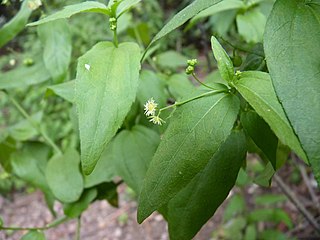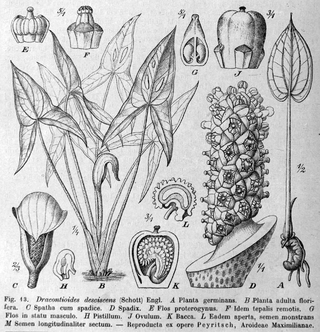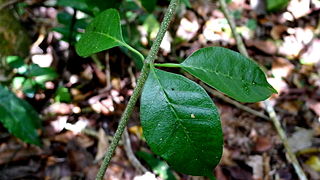
Xanthosoma is a genus of flowering plants in the arum family, Araceae. The genus is native to tropical America but widely cultivated and naturalized in other tropical regions. Several are grown for their starchy corms, an important food staple of tropical regions, known variously as malanga, otoy, otoe, cocoyam, tannia, tannier, yautía, macabo, ocumo, macal, taioba, dasheen, quequisque, ʻape and as Singapore taro. Many other species, including especially Xanthosoma roseum, are used as ornamental plants; in popular horticultural literature these species may be known as ‘ape due to resemblance to the true Polynesian ʻape, Alocasia macrorrhizos, or as elephant ear from visual resemblance of the leaf to an elephant's ear. Sometimes the latter name is also applied to members in the closely related genera Caladium, Colocasia (taro), and Alocasia.

Caladium is a genus of flowering plants in the family Araceae. They are often known by the common name elephant ear, heart of Jesus, and angel wings. There are over 1000 named cultivars of Caladium bicolor from the original South American plant.

Chiropetalum is a plant genus of the family Euphorbiaceae first described as a genus in 1832. It is widespread across relatively dry regions of North and South America from Texas to Uruguay.

Dracontium is a genus of flowering plants similar to those of Amorphophallus. Unlike Amorphophallus which is found in the Old World, this genus has a New World distribution and is native to South America, Central America, southern Mexico, and the West Indies.
Carlephyton is a genus of four species in the family Araceae, all endemic to Madagascar.

Aridarum is a genus of flowering plants in the family Araceae. All of the known species in this genus are rheophytic and are endemic to the Island of Borneo. The plant is aquatic and has willow-shaped leaves that are able to take strong currents without sustaining damage.

Asterostigma is a genus of flowering plants in the family Araceae. It is native to Brazil and Argentina. The leaves are pinnate and the plant is tuberous.
- Asterostigma cryptostylumBogner - Brasília, Goiás, Minas Gerais
- Asterostigma cubense(A.Rich.) K.Krause ex Bogner - São Paulo
- Asterostigma lividum(G.Lodd.) Engl. - southern Brazil; Misiones Province of Argentina
- Asterostigma lombardiiE.G.Gonç. - Minas Gerais, Espírito Santo
- Asterostigma luschnathianumSchott - southern Brazil
- Asterostigma reticulatumE.G.Gonç - southern Brazil
- Asterostigma riedelianum(Schott) Kuntze - eastern Brazil
- Asterostigma tweedieanumSchott - Santa Catarina in southern Brazil
Alloschemone is a genus of evergreen root climbing plants in the family Araceae that is native to the Amazon region of Bolivia and Brazil. There are only two species in the genus and both are extremely rare. These two species are Alloschemone occidentalis and Alloschemone inopinata. At one point in history, the genus Alloschemone was dissolved and added to Scindapsus, but it has since been reinstated after further observations of the plants.

Urospatha is a genus of flowering plants in the family Araceae that consists of 11 known species. They are found growing in South America and Central America in swamps, wet savannahs, and brackish water. The leaves of the species in this genus are upward pointing and sagittate (arrow-shaped). The inflorescences are quite unique; the spathe is mottled and elongated with a spiral twist at the end. The seeds are distributed by water and have a texture similar to cork that allows them to float. They also quickly germinate in water.

Dracontioides is a genus of flowering plants in the family Araceae. It was long thought to contain only a single species until a second species was described in 2005. Both are endemic to Brazil.
Zomicarpella is a genus of flowering plants in the family Araceae. It is native to Colombia, Peru and Brazil. The leaves are hastate or sagittate. The chromosome number for Zomicarpella species is 2n=26. Additionally, the seeds have an endosperm.
- Zomicarpella amazonicaBogner - Amazonas State of northwestern Brazil
- Zomicarpella maculataN.E.Br. - Colombia, Peru

Cercestis is a genus of flowering plants in the family Araceae. The species in this genus are all climbers and are native to Africa. At intervals along the stem they produce long leafless shoots called flagella. Many of the species in Cersestis show signs of fenestration.
Chlorospatha is a genus of flowering plants in the family Araceae. Chlorospatha can be found from Costa Rica, Panama, Colombia, Ecuador, and Peru.
Gorgonidium is a genus of flowering plants in the family Araceae. It is native to South America. The spathes tend to be purple and the fruits are black.
- Gorgonidium beckianumBogner - Bolivia
- Gorgonidium bulbostylumBogner & E.G.Gonç - Bolivia
- Gorgonidium cardenasianum(Bogner) E.G.Gonç - Bolivia
- Gorgonidium intermedium(Bogner) E.G.Gonç - Peru
- Gorgonidium mirabileSchott - Bolivia
- Gorgonidium striatumHett., Ibisch & E.G.Gonç
- Gorgonidium vargasiiBogner & Nicolson - Peru
- Gorgonidium vermicidum(Speg.) Bogner & Nicolson - Bolivia, northern Argentina
Scaphispatha gracilis is a species in the family Araceae. This species is native to Brazil and Bolivia, and has peltate leaves that resembles those in the genus Caladium. The species was described by Heinrich Wilhelm Schott in 1860 after he received an inflorescence of the plant. He had not however seen the plant itself and it was not rediscovered until 1976 when Josef Bogner collected tubers from the plant and successfully flowered them at the Munich Botanic Garden. Upon seeing the inflorescence it was realized that this was the plant Schott had originally described.

Spathicarpa is a genus of flowering plants in the family Araceae, all of which are endemic to South America. Spathicarpa species are notable for the fact that the entirety of their spadix is fused to the spathe. The genus is believed to be closely related to Spathantheum. The tribe Spathicarpeae is named after the genus Spathicarpa.

Taccarum is a genus of flowering plants in the family Araceae. It is endemic to South America. The genus tends to grow in rocky areas.
- Taccarum caudatumRusby - Bolivia, Peru, Acre State in western Brazil
- Taccarum crassispathumE.G.Gonç. - central Brazil
- Taccarum peregrinum(Schott) Engl. - Paraguay, southern Brazil, Misiones Province of Argentina
- Taccarum uleiEngl. & K.Krause - eastern Brazil
- Taccarum warmingiiEngl. - southern Brazil
- Taccarum weddellianumBrongn. ex Schott - Bolivia, Peru, Paraguay, central and western Brazil
Scaphispatha is a genus of flowering plants in the family Araceae. It contains two species, S. gracilis and S. robusta. The genus was believed to be monotypic until 2003 when a new species, S. robusta was discovered by Eduardo Gomes Gonçalves in northern Brazil. The plant had been grown in cultivation for some years, but had always been assumed to be a Caladium until it flowered.
- Scaphispatha gracilisBrongn. ex Schott - Bolivia, Brazil
- Scaphispatha robustaE.G.Gonç. - Pará, Mato Grosso, Tocantins, Goiás
Philonotion is a genus of plants in the family Araceae. It has three known species, native to tropical South America. Some authorities regard it as part of the related genus Schismatoglottis.
- Philonotion americanum(A.M.E.Jonker & Jonker) S.Y.Wong & P.C.Boyce - Brazil, Colombia, Venezuela, the Guianas
- Philonotion bolivaranum(G.S.Bunting & Steyerm.) S.Y.Wong & P.C.Boyce - Venezuela
- Philonotion spruceanumSchott - Venezuela, Colombia, Peru, Bolivia, northwestern Brazil

Condylocarpon is a genus of flowering plants in the family Apocynaceae first described as a genus in 1822. It is primarily native to South America, though found also in Trinidad & Tobago and Nicaragua.












